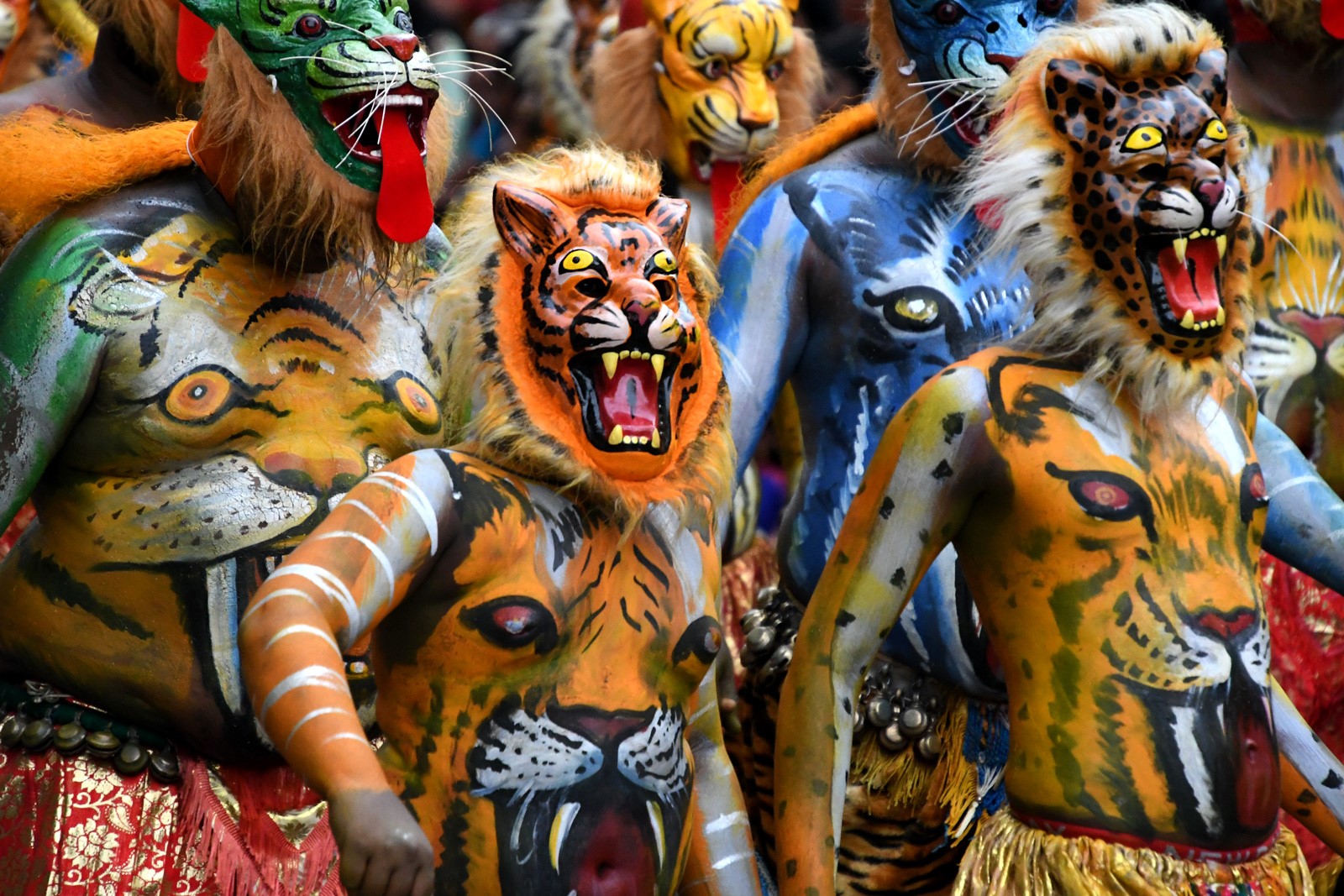Description

Disclaimer: Copyright infringement not intended.
Context
- Thrissur in Kerala recently reverberated with the energetic beats of drums and the roars of a different kind – those of 'human tigers and leopards.'
- More than 250 enthusiastic participants, adorned with vibrant stripes and spots, transformed the city into a spectacle of color and tradition during the exhilarating Pulikkali festival.
- This rollicking show served as the grand finale to the Onam celebrations, creating a carnivalesque atmosphere in Thrissur.
Details
The Puli Kali Experience
- In this unique celebration, participants, or 'human tigers and leopards,' paint their bodies to resemble these majestic animals, creating a visually stunning and vibrant display.
- The 'tigers' from five different contingents representing Ayyanthole, Viyyur, Sitaram Mill Lane, Sakthan, and Kanattukara flooded the streets of Thrissur, each group donning a distinct array of colors.
- From traditional tiger stripes to unexpected fluorescent green and pink hues, the participants brought a kaleidoscope of shades to the festival.
- Pulikkali does not adhere to rigid rules for dance movements. Each artist creates their unique style, resulting in a dynamic and individualistic performance.

About
- Puli Kali, also known as "Puli Kali" or "Puli Kettu," is a vibrant and colorful traditional folk art form and cultural event that is celebrated primarily in the Indian state of Kerala.
- Puli Kali translates to "Tiger Play" or "Tiger Dance," and it involves performers painting their bodies to resemble tigers and leopards and dancing in the streets to the beat of traditional percussion instruments.
History of Puli Kali
- The history of Puli Kali can be traced back to over two centuries.
- It is believed to have originated in the 18th century in the Thrissur district of Kerala.
- The credit for its creation is often given to Raja Rama Varma, also known as Sakthan Thampuran, the Maharaja of Kochi. He is said to have introduced this art form as a way to boost the festive spirit and add entertainment to the Onam celebrations.
- Pulikkali, believed to have originated as a street dance form two centuries ago, eventually became an integral part of Onam celebrations.
- Initially, it faced criticism for being rather obscene, but over time, certain rules regarding style and dance steps were introduced, enhancing its popularity and cultural significance.
- In recent years, women have broken barriers in Pulikkali. In 2016, they stormed into what was traditionally a male-dominated arena.
Significance of Puli Kali
- Cultural Significance: Puli Kali is a celebration of Kerala's rich cultural heritage. It brings together people from various communities and backgrounds to participate in and witness the vibrant performances.
- Festival Highlight: Puli Kali is one of the highlights of the Onam festival, which is celebrated to commemorate the return of the mythical King Mahabali. It adds excitement and enthusiasm to the festivities.
Dance and Music
- Puli Kali is a dance-based performance. The "tigers" dance to the rhythm of traditional percussion instruments like chenda and thakil. The synchronized movements and energetic dance routines are an integral part of the performance.
.jpg)
Conclusion
Pulikkali is more than just a festival; it's a vibrant and dynamic celebration of Kerala's cultural heritage. With its unique blend of art, tradition, and inclusivity, Pulikkali continues to roar its way into the hearts of both participants and spectators, adding a splash of color and excitement to the Onam festivities in Thrissur.
|
PRACTICE QUESTION
Q. What is the primary theme and significance of the traditional Indian festival known as "Puli Kali"?
1. Puli Kali involves body painting and dance to resemble tigers and leopards.
2. It is celebrated in Kerala as part of the Onam festival.
3. Puli Kali is primarily a religious ritual associated with harvest festivals.
Options:
A. Only Statement 1 is correct.
B. Statements 1 and 2 are correct.
C. Statements 2 and 2 are correct.
D. All three statements are correct.
Correct Answer: B
|
https://www.thehindu.com/news/national/kerala/thrissur-rocks-to-the-rhythm-of-pulikkali/article67260629.ece
















